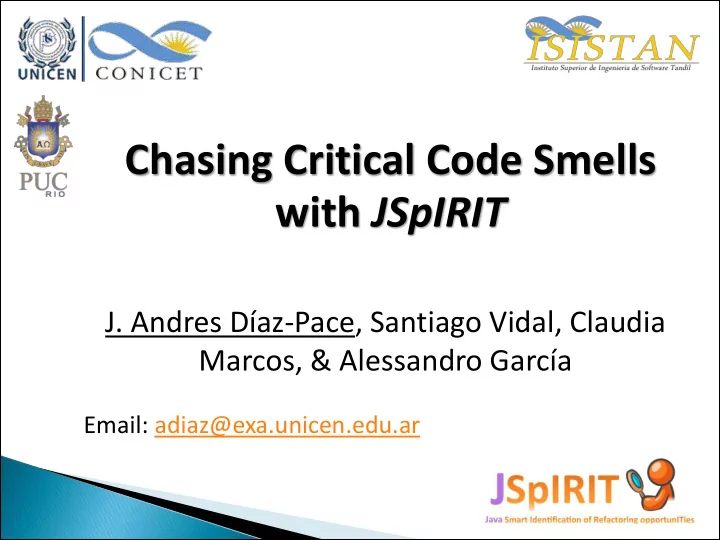

Chasing Critical Code Smells with JSpIRIT J. Andres Díaz-Pace, Santiago Vidal, Claudia Marcos, & Alessandro García Email: adiaz@exa.unicen.edu.ar
Agenda • Code smells as symptoms of design problems • Detection + Prioritization criteria JSpIRIT tool & framework 3 criteria based on architectural information • Demo: Mobile Media • Lessons learned Next steps • 2 SATURN 2016
About Code/Design smelling bad -1 • Any software system evolves architecture decay Drift Erosion • Technical debt not properly managed • … or simply bad design decisions Code Smell lls [Fowler1999] (or code anomalies) that slipped off since early stages Symptoms in the source code that can indicate a (structural) problem 3 SATURN 2016
About Code/Design smelling bad -2 • Any software system evolves architecture decay Drift Erosion • Technical debt not properly managed • … or simply bad design decisions Code Smell lls [Fowler1999] Intensive Coupling God Class (or code anomalies) that slipped off since early stages Symptoms in the source code that can indicate a (structural) problem … should they (all) be refactored? 4 SATURN 2016
Code Smells Catalog & Tools • God class • Brain class • Brain method (BM) • Data class • Some available tools • Dispersed coupling (DE) JDeodorant • Feature envy (FE) iPlasma & inFusion • Intensive coupling DECOR PMD • Refuse parent bequest SonarQube (plugins) • Shotgun surgery … • … Smells with different granularity Automated detection strategies Not all tools always agree on their metric-based outputs [Lanza&Marinescu2016] 5 SATURN 2016
Smells are not created equally … Need to prioritize “critical” smells • Problems of existing tools [Vidal2014, Vidal 2015] Numerous code smells are reported (including false positives) Using archit hitect ectura ural l inform rmat atio ion Developers get quickly to inform prioritization criteria overwhelmed 1. Modif 1. ifiabili iability y scena nario rios Budget for refactoring is 2. Archit 2. hitect ctural ural concerns cerns often limited 3. Archit 3. hitect ctural ural compo ponent nents The refactoring of 4. 4. Chang nge e history ry particular smells contribute differently to the system goals or its health 6 SATURN 2016
JSpIRIT - Architecture http://tinyurl.com/j2qoypc 5) Browse top-ranked smells, Project source code refactor, etc. 1) Adjust metrics 3) Prov ovide de scen enarios os End-user /concer cerns/compon onen ents ts (deve velop oper) 2) Selec ect criter erion on JSpIRI RIT Develop oper 4) Analyze ze rankin king of smells 7 SATURN 2016
Criterion #1: Modifiability Scenarios • Relationship of code smells with quality-attribute scenarios A change-related property that is desirable in the system • e.g., A developer wishes to add a new kind of screen for displaying a picture. This change should be made at design time, and it should take less than 1 hour to make and test the change, with no side-effect changes. • Intuition: Smells that intersect with the elements affected by a scenario are more critical (than other smells) Rippling effect to other classes • Scenario mappings to code are necessary 8 SATURN 2016
Criterion #2: Architectural Concerns • A crosscutting concern represents some important part of the problem (or the domain) that designers want to treat in a modular way • Intuition: Smells affected by several concerns are more critical • Possible concern entangling • Rippling effect • Concern mappings to code are necessary 9 SATURN 2016
Criterion #3: Architectural Components • Filtering smells that belong to a given architectural component • Intuition: Assumption that certain components are more critical (or sensitive to changes) than others • Business logic • Legacy 10 SATURN 2016
JSpIRIT Demo: Mobile Media 11 SATURN 2016
• Scenarios • Concerns • Components 12 SATURN 2016
Experiences: Understand & do refactoring • So far applied in 5 Java systems Health Watcher (academic, 8 KLOC, 372 classes, Web, 58 smells) Mobile Media (academic, 5 KLOC, 50 classes, mobile SPL, 45 smells) SubscriberDB (8 KLOC, 193 classes, desktop, 82 smells) Beef-Cattle Farm Simulator (industrial, 38 KLOC, desktop, 372 classes, 523 smells ) HR Appraiser (industrial, 83 KLOC, 884 smells , in progress) • Good precision: ~70% of top-10 smells were critical Based on validation of rankings against “key classes” or design problems judged by system experts Combination with change-related historical information , which helps to discard smells in “stable/unchanged” classes (not covered here) • Depends on quality of code mappings 13 SATURN 2015
Conclusion & Next Steps • Analysis/prioritization for other quality-attribute scenarios Performance (static + dynamic analyses) joint project with RSS Group, at Stuttgart University Battery consumption (Android ) • Groups of code smells agglomerations • Stronger indicators of design problems joint project with Opus Group, at PUC-Rio University • New version of JSpIRIT to be released • Better visualization capabilities For both code smells and agglomerations • Automated search for refactoring suggestions Initial experiments with Brain Method 14 SATURN 2016
Thank you! & QA Santiago Vidal svidal@exa.unicen.edu.ar J. Andres Diaz-Pace adiaz@exa.unicen.edu.ar Claudia Marcos cmarcos@exa.unicen.edu.ar Alessandro F. Garcia afgarcia@inf.puc-rio.br 15 SATURN 2016
Recommend
More recommend